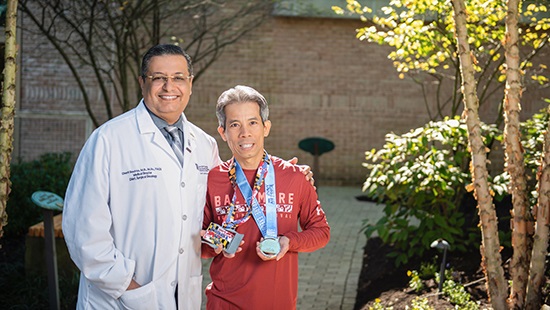Cancer
How This Marathon Runner Beat Liver Cancer

"I was just numb. I was in total shock," Columbia resident Nhan Le recalls about his reaction to his liver cancer diagnosis at age 45. "I had no family history of cancer."
Le is an avid runner who has participated in marathons and races for the last several years. This past year, though, he was up against his toughest competition. He needed to cross the finish line in successfully beating cancer.
In his youth, Le contracted hepatitis B, which is prevalent in his native country, Vietnam. Hepatitis B can eventually lead to liver cancer, but because of his active lifestyle of running and swimming, Le did not think he would be at high risk.
Le's primary care doctor was more cautious and ran blood tests during annual checkups to make sure everything was normal. When irregular labs came back, more tests were needed.
Le ultimately had a liver biopsy that revealed a cancerous tumor the size of a peach on his liver.
A Challenging Surgery
The next question out of Le's mouth was, "So what do I do now?"
His primary care doctor referred him to an oncologist, but surgery was the best first step. Le saw one surgeon who recommended a liver transplant. Le was worried the wait for the organ would take a long time. He also saw Cherif Boutros, MD, medical director of the University of Maryland Baltimore Washington Medical Center's Tate Cancer Center in Glen Burnie, chair of surgical oncology at UM BWMC and associate professor of surgery at the University of Maryland School of Medicine.
"The best treatment option for Mr. Le was a surgical resection where you thoroughly take out the tumor," Dr. Boutros says. "But achieving a full resection with negative margins can be challenging because we don't have a lot of space on the liver, especially with a large tumor. We needed to remove the tumor completely and make sure Mr. Le could get back to his athletic lifestyle."
Dr. Boutros used a minimally invasive liver resection with a microwave ablation margin accentuation. "Microwave ablation is similar to boiling an egg; we use the same microwave technology," Dr. Boutros says. "The egg will look the same after you cook it, but it is not alive and it cannot become a chicken. We cook the area around the tumor, making it basically bloodless, and kill all microscopic cancer cells so it cannot spread. We then remove it completely."
Back to Running
The surgery was a success, and Le was discharged from the hospital faster than expected. "Everyone was in shock when we sent him home on day two, but he was doing so well and he was in no pain," Dr. Boutros says. "He is doing great and was back to running in no time."
Le was sore when he got home, but he followed the advice of his caretakers, in particular his physical therapist, who taught him to maneuver, especially on steps, one foot at a time. At this rate, Le was skeptical about how quickly he would get back to running, but that was still one of his biggest goals.
When he regained more strength, Le started taking short walks with his wife. That quickly progressed to longer walks. Three months after surgery, he was back to running upwards of 40 miles a week.
"While I was healing, I started to believe to never give up no matter what," Le says. "Life has so many beautiful things to offer, you have to move forward. My wife, my daughter, my in-laws, my friends—they always supported me through this entire situation, and I am very grateful for that."
Throughout this journey, Le held on to the belief that you should never let yourself feel defeated. This positive attitude helped him cross the cancer finish line, and now he has countless more finish lines to cross in running. This past fall, he successfully completed the Baltimore Marathon.
"The more I run, the more I relieve stress. It makes me happier when I run because I did something for myself. That keeps moving me forward."
This story was originally published in the Winter 2019 issue of Maryland’s Health Matters.
